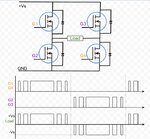sam781
Full Member level 4
Do I need both? If I operate IR2110 with 12 volt?No ! a shifter needed between these sections ! ( between micro and main driver ! ) 5 to the 15 !
I was talking about the max voltage which will be available at the Transformer output. Say, input voltage is 12v, trans ratio is 34; so, output voltage=12*34=408goldsmith said:No ! if your topology is push pull the stress across the DS will be 2vm ! 2*325 ! ( at least ) .
In this case, duty cycle has to be around 80% to get avg voltage 325v to be used as inverter input.

